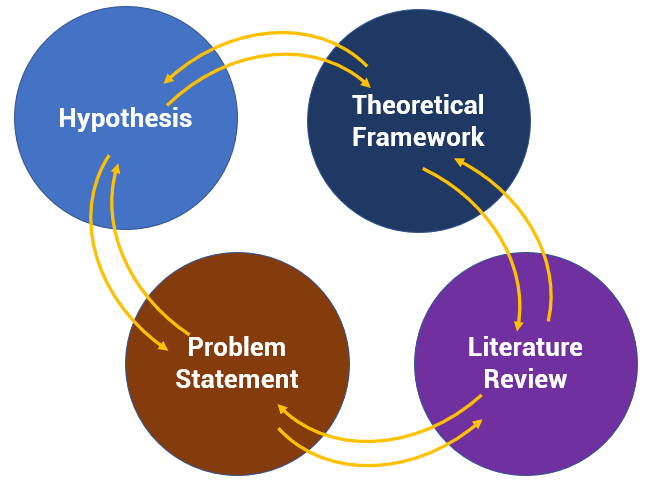Two Greek words constitute the word hypothesis “hypo” means under and “tithemi” means place. The dictionary meaning is “An idea or explanation for something that is based on known facts but has not yet been proved.”
Definition
“Hypotheses are single tentative guesses, good hunches – assumed for use in devising theory or planning experiments intended to be given a direct experimental test when possible”. – (Eric Rogers, 1966)
“A hypothesis can be defined as a tentative explanation of the research problem, a possible outcome of the research, or an educated guess about the research outcome.” (Sarantakos, 1993: 1991)
In research, hypothesis formulation is fundamental. Theory building and theory testing are two essential parts of every research process. Testing hypothesis includes a collection of data (Identify the types of data), analysis of data and interpretation thereof. A theory provides a representation of just some of the aspects of a real-world phenomenon. In theory, thus only a limited part of the real-word phenomenon is represented (Dubin, 1976). We can express this partial representation of the real-world phenomenon through a statement, or proposition is called a hypothesis. This statement is a conjecture about the real-word reality.
For example:
- Organizational commitment is positively associated with employees’ job autonomy.
- Organizational commitment is positively associated with employees’ job satisfaction.
- Organizational commitment is negatively associated with employees’ intention to quit the job.
- Organizational commitment is negatively associated with a lack of supervisor support.
Here these statements are the inference about the partial organizational reality, not in full. These statements are propositions or hypothesis. It tries to establish the relationship between the concepts or variables like, “organizational commitment”, “job autonomy”, “job satisfaction”, “intention to quit”, and “supervisor support”.
Through this inference, here we have created some output statements about the organizational reality. So it is considered as the output part of the theory. For an empirical study, we can test it.
So it is a tentative statement about the relationship of variables or concepts under study. Though a scientific way, we can test this hypothesis. It is is a prediction or a tentative answer to the research question. It can be an assumption or status quo, which has already given about the reality or a claim or assertion which is unknown to the researcher.
Hypothesis Formulation
The formulation of the hypothesis purely depends on the nature and context of research. The formulation starts at the identification of the research problem. It suggests an answer to the research question. A research question may be in a question form, but a hypothesis should be in declarative form.
It must be assessable and quantifiable so that the statistical authenticity of the relationship can be confirmed. It should be an inference description based on the existing literature and theories about the problem and not based on the gut feel or personal judgment of the researcher.

Descriptive and Relational Hypothesis
A hypothesis can be descriptive or relational. Relational hypothesis state the expected relationship between two variables or concepts under study. For depicting the relationship between variables, it can use words like greater than, less than, increase, decrease. So it is a directional hypothesis or one-tail hypothesis.
Example
- Advertisement increases the sales
- Higher the employees’ satisfaction, higher the organisational commitment.
Sometimes we cannot express the research problem through the relationship, but only through the magnitude, trend, or behavior of the population under study. It is called a descriptive hypothesis. It describes the population under study in different angel, instead of establishing the relationship of variables, which is based on some presumptions based on past literature.
Example
- The attrition rate in the BPO sector is almost 33 percent.
- The literacy rate in the city of Tokyo is 100 percent.
A hypothesis represents what a researcher expects to find in the study. It is evident that a well-crafted hypothesis suggests the best way to perform the research

